Popov K.I., Djokic S.S., Grgur B.N. Fundamental Aspects of Electrometallurgy
Подождите немного. Документ загружается.

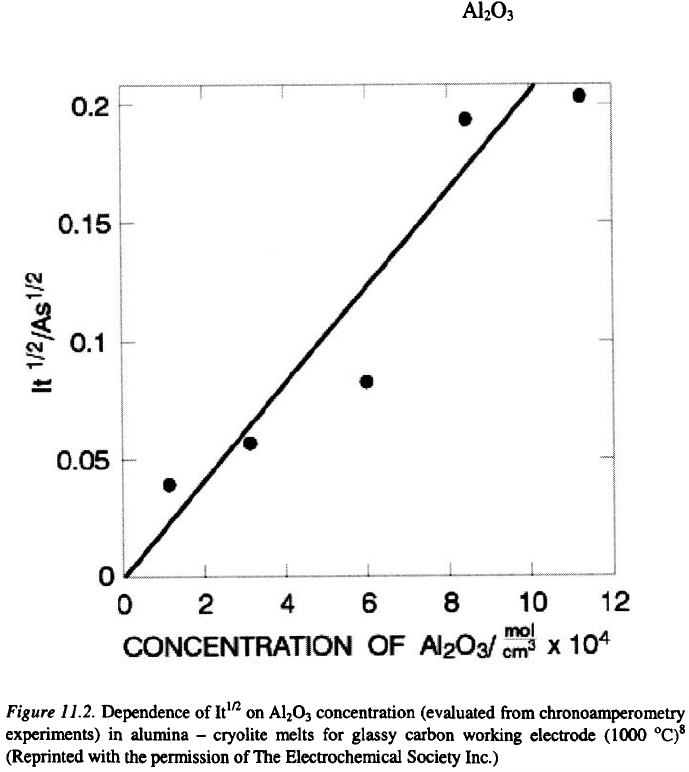
282
Chapter 11
solutions for analytical purposes under conditions of semi-infinite linear
diffusion to a planar electrode, much less work has been carried out on the
corresponding problem in molten salts at higher temperatures, when many
new serious experimental problems arise.
Anodic behavior in alumina-cryolite melts was studied on carbon, gold
and platinum electrodes by means of chronoamperometry. At the graphite
materials, the anode processes are not fully diffusion controlled, nor are the
results adequately reproducible. At the glassy carbon electrode, anodic
processes are diffusion controlled. This is illustrated in Figure 11.2. As this
figure shows with increasing concentration of in the melt, the
corresponding current function increases in a satisfactory linear way.
The departure from classically expected behavior at graphite materials is
due to the reduction of the electrode surface in contact with the melt, which

11. Electrodeposition of Metals from Molten Salts
283
is caused by the build-up of evolved adherent gas bubbles or gas films at the
electrode surface.
The results indicate kinetic difference between the anodic reactions of the
graphites and glassy carbon. Evidently, the kinetic reactivity of glassy
carbon for anodic oxidation in the melt is more facile than that for graphite
where their electro-oxidation is not fast enough to become limited by
diffusion control, implying a relative slow electrode process. This difference
could be attributed to the relative stability of the structure of graphite
associated with its multiple conjugated bonding in contrast to that in glassy
carbon, especially on the basal-plane exposures of the graphite crystals of
the materials.
At platinum electrode anodic reactions are limited by the formation of an
oxide film, which obeys, kinetically, Wagner’s parabolic growth law:
where
y
is the film thickness, K is a constant depending on the diffusion
coefficient oxygen-containing species. For platinum electrode the current
response function does not depend on the concentration.
To diminish the effect of convection on the electrode-kinetic behavior of
the electrochemical reactions, as well as to minimize disturbances at the
interface due to evolution of gas, the method of fast cyclic voltammetry for
study of the anodic processes in cryolite-alumina melts can be profitably
used. Using very fast cyclic voltammetry researchers found four to five
current peaks in the range 1 to 4 V. The shape and the peak current values in
cyclic voltammograms depend on the kind of carbon material used as the
working electrode in the investigation of anodic reactions in alumina-cryolite
melt.
Typical examples of cyclic voltammograms obtained at different carbon
materials, are presented in Figures 11.3. and 11.4. For the example of
graphite ATJ, four distinguishable anodic current peaks appeared at
approximately 1.1, 1.95, 2.45 and 3.3 V.
In the case of glassy carbon, on the negative going sweep curves of the
voltammogram, between 2 and 3.2 V relatively high anodic currents were
recorded (Figure 11.4.). The sharp decrease in the current at 3.5 V, and a
subsequent absence of current flow on the reverse sweep between 4 and 3.2
V clearly indicate the occurrence of an “anode effect” (see later discussions).
Around 3.2 V, the anode comes out of the “anode effect” permitting current
to flow again. The discussion of the cyclic voltammetry results is restricted
on the second peak at the several kinds of carbon anode materials
investigated. Although the peak current increase with increase of the square
root of the sweep rate for all the kinds of carbon investigated, these
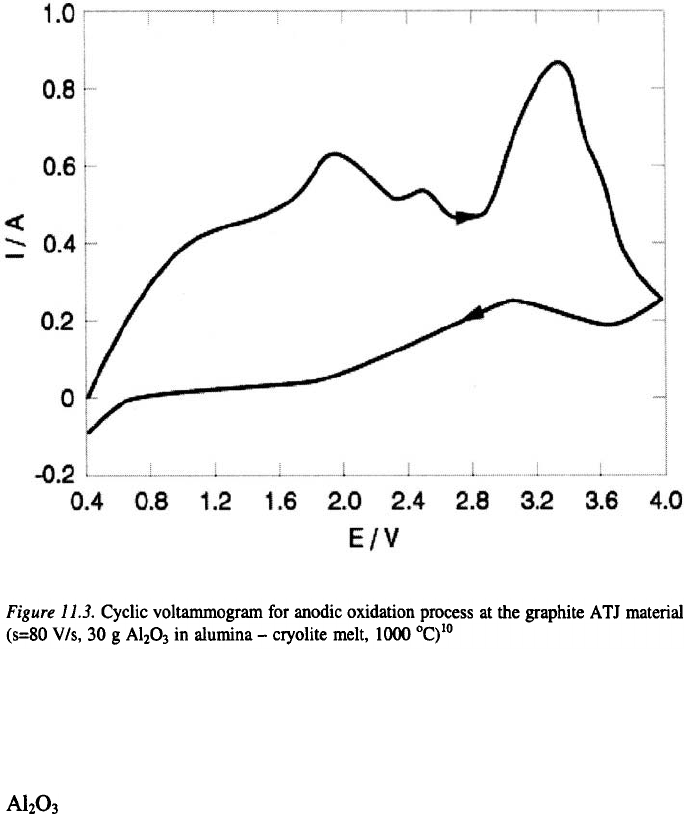
284
Chapter 11
dependencies with the exception of that at glassy carbon, do not show
expected linear relationship. At glassy carbon, however, the dependence of
peak current on the square root of the sweep rate is linear for all
concentrations of alumina. Furthermore, on glassy carbon electrode, the
dependence of the peak current values on alumina content in the range 1.45 –
4.23 wt.% was observed to follow a satisfactory linear relationship as shown
in Figure 11.5.
10
This result indicates that the process is diffusion controlled under these
conditions. At graphite materials the results were not reproducible, nor was
there any observable linear relationship between current maxima values and
concentration. The background current behavior also depends on the
carbon material. In this way a material dependent modification of the
expected ideal current response to alumina concentration is an additional but
unavoidable complication.
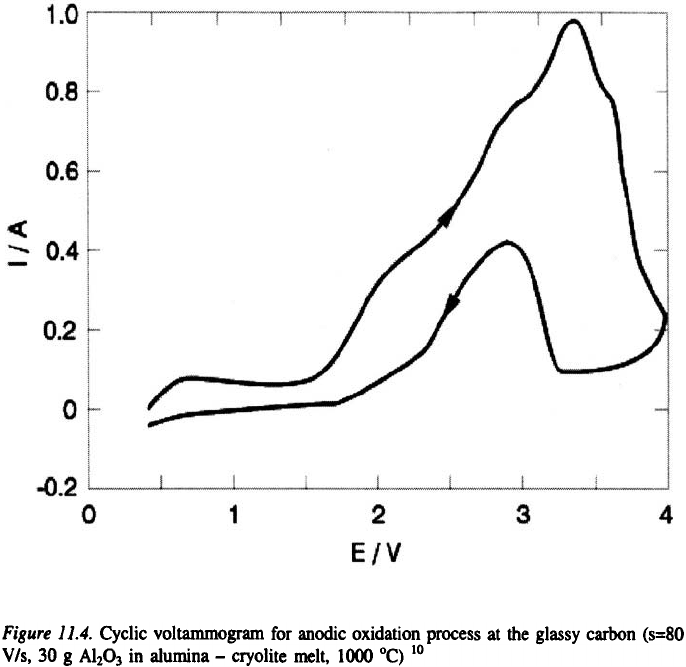
11. Electrodeposition of Metals from Molten Salts
285
The AC impedance method has also been applied to and investigated for
the study of the anodic processes in the electrolysis of alumina-cryolite melts
at carbon.
11
This method is used to investigate the discharge of the
oxyfluoroalumnate ion at a graphite electrode. An increase of the applied
anodic overvoltage leads to a variation of the shape of the complex-plane
impedance diagram. For zero overvoltage with a residual alumina
concentration of 0.46 wt.%, the plot of imaginary part of the impedance (
Z
”)
versus the real part of the impedance (
Z
’) follows a linear relationship
having a 45 ° slope, which is recognized as diffusion impedance. With
further increase of the overvoltage, the plots of Z
’
versus
Z
” show inflections
of the straight line and these are more pronounced as the overvoltages
applied to the electrode are increased. An inductive loop appears at low
frequencies. The change in the shape of the
Z
’ versus
Z
” plot with increase
of the overvoltage was explained by the influence of reactions producing
bubbles of gaseous compounds of oxygen with carbon which disturb and
reduce the thickness of the diffusion layer.
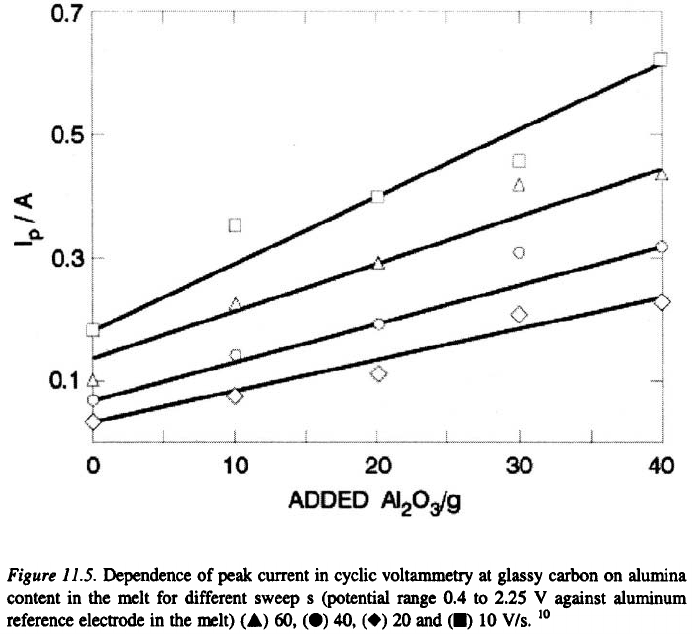
286
Chapter 11
In spite of the intensive studies of alumina-cryolite melts by various
electrochemical techniques, significant disagreements among results
appeared in the published literature. These problems are consequences of
nonreproducibility of results which arise due to the nature of the carbon
sensor electrode materials used and, also due to a number of technical
problems including the presence of dissolved aluminum metal in realistic
practical systems.
11.3 THE ANODE EFFECT
The anode effect is a phenomenon that has been observed in many
processes involving the electrolysis of molten salt. It is described as a
blockage effect, which inhibits the current flow between the anode and the
melt. Due to gas evolution, growth of bubbles and their coalescence occur
covering most if not entire surface of the anode. In industrial cells during
electrolysis of alumina-cryolite melt the anode effect manifests itself through

11. Electrodeposition of Metals from Molten Salts
287
an immediate increase of cell voltage from values between 4.1 and 4.3 V,
during normal electrolysis to about 35 to 60 V, and sometimes even up to
130 V, depending on the current density.
7
The cell remains under the
influence of the anode effect until the current is interrupted, which allows
adherent gas bubbles formed at the anode surface to collapse or become
detached. The effect is somewhat analogous to that observed in anodic
evolution at carbon from KF 2HF melts in commercial cell operation.
The reasons for appearance of the anode effect are not yet established.
Chemical analysis of the anode gases shows that they contain up to 30 %
fluorine compounds such as and The presence of fluorocarbon
compound promotes dewetting of the anode surface and the growth of large
bubbles. In industrial cells the anode effect arises when the alumina
concentration in the melt is between 0.5 and 2 %. Thus, maintaining good
control of alumina content is very important factor in avoiding the anode
effect. Upon an occurrence of the anode effect, the crust on the top of the
melt is broken and alumina is added.
Conditions for onset of the anode effect are associated mainly with the
depletion of alumina concentration in the melt during electrolysis, increasing
potential, and presence of fluorocarbon surface compounds at the carbon
anode surface, causing dewetting of the anode by the electrolyte and
adherence of gas bubbles.
12
11.4 NONCONSUMABLE ANODE MATERIALS IN
MOLTEN SALTS ELECTRODEPOSITION
In the electrowinning of metals from their molten salts, due to significant
corrosion at higher temperatures and anodic reactions involved in the process,
the graphite or other anode materials are often very easily consumed.
The search for nonconsumable, or inert anodes, has been an important
research activity for a long time, especially in the electrolysis of alumina-
cryolite melts, which will mostly be discussed here, although other molten
salts, depending on their composition and conditions have attracted
considerable attention. The requirements for materials, which could be used
as anodes for in alumina-cryolte melts include resistances to attack by
molten cryolite and oxygen, high electronic conductivity, mechanical
strength and resistance to thermal shock. The possibility of using
nonconsumable anodes in the electrowinning of alumina has become
attractive for the following reasons:
(i)
(ii)
These anodes would not be consumed during electrolysis
The oxygen which would be formed at the anode could be utilized
industrially
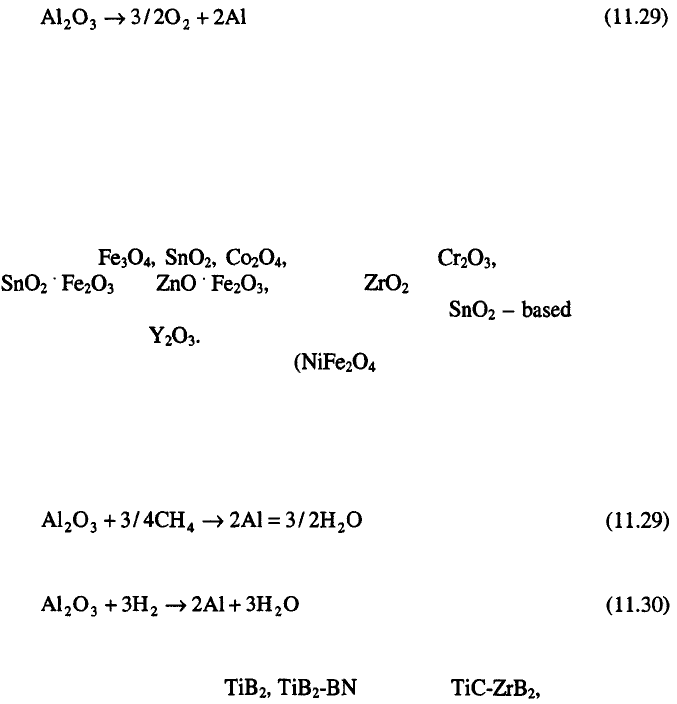
288
Chapter 11
(iii)
(iv)
(v)
The problems related to contamination of the working environment,
when the Hall-Héoult process is used could be reduced
The corresponding cell design would permit electrolysis with higher
current efficiencies than is currently possible with carbon anodes.
All above-mentioned factors could represent significant savings to
the aluminum production industry.
In the case of nonconsumable anodes, the production of aluminum would
be represented formally by the equation:
(E°=-2.19 V at l010°C
)
In the search for an inert anode for use in the Hall-Héroult electrolysis,
among many accessible materials, oxides, metals, refractory hard metals and
gaseous fuel anodes have been investigated.
13
Among the oxides, investigated as materials for anodes in electrolysis of
an alumina-cryolite melt should be mentioned the cold pressed and sintered
anodes of NiO, CuO and the ferrites such as
and stabilized as a possible inert material for
production of less corrosion resistant anodes, the anodes and
complex anodes
The Cu-containing cermets spinel, NiO and metallic phase
which is mostly Cu) have also been investigated as possible anode materials
for the primary aluminum industry.
In the case of gaseous-fuel anodes, the production of aluminum metal is
described by the following reactions:
The hard refractory materials such borides, carbides and nitrides of the
transition metals such as mixtures, MoSi and TiCr
should be mentioned.
Metal anodes such as copper, nickel, chromium, tungsten stainless steel
and silver are unresistant in alumina-cryolite melts. On platinum and gold,
formation of oxide films and/or corrosion occurs.
It seems that oxide materials (nickel ferrites type) are the most promising
by far.
14
However, as research shows the solubility of alumina in cryolite
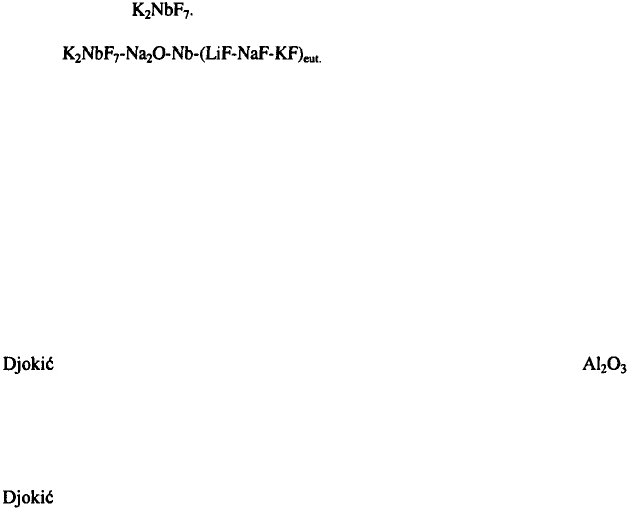
11. Electrodeposition of Metals from Molten Salts
289
melts is dependent on the content of alumina. In order to exhibit a slow
dissolution of oxide anodes, the alumina concentration should be maintained
at a relatively high level. The alumina content in the industrial cells with
graphite anodes is maintained at 2 to 4 %. If the oxide type of anodes are to
be used in the production, the content of alumina in the melt should probably
be kept at higher levels, which should be determined by the additional
studies.
11.5 FURTHER READINGS
1.
2.
3.
4.
5.
6.
7.
8.
9.
10.
11.
12.
13.
14.
Cathro K.J., Deutcher R.L., Sharma R.A. Electrowinning Magnesium from Its Oxide in a
Melt Containing Neodymium Chloride. J. Appl. Electrochem. 1997; 27:404-413.
Polyakov E.G., Polyakova L.P., Elizarova I.R. Cathode Processes in Chloride-Fluoride
Melts containing Elektrokhimiya 1995; 31: 502-509.
Rosenkilde C, Vik A., Østvold T., Christensen E. Electrochemical Studies of the Molten
System at 700 °C. J. Electrochem. Soc. 2000; 147:
3790-3800.
Katagari A., Suzuki M., Takehara Z. Electrodeposition of Tungsten in XnBr2-NaBr and
ZnCl2-NaCl Melts. J. Electrochem. Soc. 1991; 138:767-773.
Janz G.J., Reeves R.D. “Molten Electrolytes – Transport Properties” In Advances in
Electrochemistry and Electrochemical Engineering, Vol. 5, Tobias C.W., ed., pp. 13 –
171, New York: Interscience Publishers, 1967.
Haupin W.E., Frank W.B. “Electrometallurgy of Aluminum” In Comprehensive Treatise
of Eelctrochemistry, Vol.2: Electrochemical Processing, Plenum Press, Bockris J.O’M.,
Conway B.E., Yeager E., White R.E., eds., pp. 301 – 325, New York: Plenum Press,
1981.
Grjotheim K., Krohn C., Malinovsky M., Matiasovsky K., Thonstad J. Aluminium
Electrolysis, Fundamentals of the Hall-Héroult Process, Second Edition, Aluminium
Verlag, Dusseldorf, 1982.
S.S., Conway B.E. Electroanalytical Methods for Determination of in
Molten Cryolite, In Modern Aspects of Electrochemistry, Vol. 26, Conway B.E., Bockris
J.O’M, White R.E., eds., pp. 229 – 275, New York: Plenum Press, 1994.
Dewing E. W., van der Kouwe E.T. Anodic Phenomena in Cryolite Alumina Melts. I.
Overpotentials at Graphite and Baked Carbon Electrode. J. Electrochem. Soc. 1975; 122:
358-363.
S.S., Conway B.E., Belliveau T.F. Specificity of Anodic Processes in Cyclic
Voltammetry to the Type of Carbon Used in Electrolysis of Cryolite – Alumina Melts”,
J. Appl. Electrochem., 1994; 24: 827-834.
Picard G., Prat E.C. Evidencing the Electrochemical Mechanism at carbon Bath Interface
by Means of Impedance Measurements: An Improved Approach to the Aluminum
Reduction Process In Light Metals, Zabreznik R.D. ed. The Metallurgical Society,
pp.507-517, Warrendale, Pennsylvania, 1987.
Vogt H. Effect of Alumina Concentration on the Incipience of the Anode Effect in
Aluminium Electrolysis. J. Appl, Electrochem., 1999; 29: 779-788.
Ballehang K., Oye H.A. Inert Anodes for Aluminium Electrolysis in Hall Héroult Cells.
Aluminium, 1981; 57: 146-150.
Olsen E., Thonstad J. Nickel Ferrite as Inert Anodes in Aluminium Electrolysis. J. Appl.
Electrochem., 1999; 29: 293-311.
This page intentionally left blank
Chapter 12
ENVIRONMENTAL ISSUES
The metal processing industry produces various toxic gases and aqueous
effluents containing ions of heavy metals, or in some case cyanides. Most of
these metals are toxic. Regulations of the Environmental Protection Agency
(EPA) require specific control of all air pollutants and hazardous waste.
Areas of the environmental management in the electrometallurgy field
involve air pollutants, and other waste treatment and disposal. In order to
minimize the negative impacts of industries involving electrowinning,
electrorefinery and plating technologies to the ecosystem, an adequate
treatment of environmental should carefully be taken into consideration.
Safety management in the electrometallurgy is directed towards electrical
hazards, explosion hazards and hazards arising due to handling and exposure
to dangerous chemicals.
The electrical hazards arise from the fact that the electrometallurgical
plants and plating shops operate with both direct and alternating currents.
Most cells are designed in a way to minimize potential difference from the
ground potential. In some plants (i.e., aluminum electrowinning from alumina-
cryolite melts) strong magnetic fields are generated in cell rooms. The
regulations prohibit magnetic and conductive materials in the cell rooms.
The explosion hazards depend on the system, but are often associated
with plants in which, hydrogen and chlorine evolution reactions are involved
in the process. Other explosion hazards may include chemicals, i.e. reactive
metals such as alkali metals, magnesium etc. The regulations in this case
require proper safety equipment (e.g., glasses, masks, aprons etc.).
Discussion in this chapter is divided into following sections:
(i)
(ii)
(iii)
Environmental concerns in the electrowinning and electrorefining
from aqueous solutions
Environmental concerns in molten salts electrolysis
Environmental concerns in electroplating technologies
291
